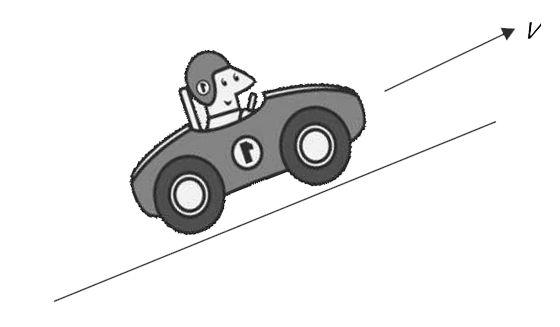A small car took off a ramp at a speed of 30m/s. Immediately after leaving the ramp, the driver applied brakes on all the wheels. The brakes retarded the wheels uniformly to bring them to rest in 2 second. Calculate the angle by which the car will rotate about its centre of mass in the 2 second interval after leaving the ramp. Radius of each wheel is r=0.30m . Moment of inertia of the car along with the driver, about the relevant axis through its centre of mass is IM=80kgm2 and the moment of inertia of each pair of wheels about their respective axles is 0.3kgm2. Assume that the car remained in air for more than 2 second . Also assume that before take- off the wheels rolled without sliding.

The correct Answer is:340rad≅43∘
Topper's Solved these Questions
Similar Questions
An autmobile moves on road with a speed of 54km/h. The radius of its wheel is 0.45m and the moment of inertia of the wheel about its axis of rotation is 3kgm2. If the vehicle is brought to rest in 15s, the magnitude of average torque tansmitted by its brakes to the wheel is :
View SolutionA car moves on a road with a speed of 54kmh−1. The radius of its wheels is 0.35m. What is the average negative torque transmitted by its brakes to the wheels if the car is brought to rest in 15s? Moment of inertia of the wheels about the axis of rotation is 3kgm2.
View Solution
Knowledge Check
A car is travelling with a speed of 36 km/hr.The driver applies the brakes & retard the car uniformly.The car is stopped in 5 seconds. The retardation of the car
A2 m/s^2B3ms2C4ms2D6ms2What happens to the speed of a moving car when force is applied in the opposite
ASpeed increasesBSpeed decreasesCNo change in speedDChange in directionAn autmobile moves on road with a speed of 54km/h. The radius of its wheel is 0.45m and the moment of inertia of the wheel about its axis of rotation is 3kgm2. If the vehicle is brought to rest in 15s, the magnitude of average torque tansmitted by its brakes to the wheel is :
A2.86kgm2s−2B6.66kgm2s−2C8.58kgm2s−2D10.86kgm2s−2
A car was movig at a rate of 18kmh−1 . When the brakes were applied, it comes to rest in a distance of 100 m. Calculate the retardation produced by the brakes.
View SolutionA car was movig at a rate of 18kmh−1 . When the brakes were applied, it comes to rest in a distance of 100 m. Calculate the retardation produced by the brakes.
View SolutionAn 800-kg car is moving at a speed of 90 km/h. it takes 5s to stop after the brakes are applied. The force applied by the brakes will be _______ .
View SolutionAn automobile moves on road with a speed of 54km/h. The radius of its wheel is 0.45m and the moment of inertia of the wheel about its axis of rotation is 3kgm2. If the vehicle is brought to rest in 15s, the magnitude of average torque transmitted by its brakes to the wheel is :
View SolutionIn 1978, a New Zealand motorcylist roared off a 36∘ ramp at a speed of 30m/s, flying into the air, overa parked airplane anddown onto ramp at the same level. Some withnesses knew from the engine noise that the man had made a fatal mistake. As soon as the jump began, he should have closed the throttle to stop driving the rear wheel. Instead, he kept thethrottle wide open. When the motorcycle left the ramp and friction disappeared, the rear wheel suddenly spun up to itws maximum angular speed ωwf of 160rad/s and themotorcycle began to rotate around its centre of mass. Thus the motorcycle was far from the correct orientation whenit reached the second ramp.
Assume the following. The wheel radius was 0.30m the rotational inertial IC of the motorcycle about its center of mass was 20kg.m2, and the rotational inerfia Iw of the rear wheelabout its centre was 0.40kg.m2. Also assume that ωwf was reached immediatelyafter takcoff, and neglect any effect of theman on the motorcycle. Suppose the motorcycle moved from right to left and before take off, the wheel rolled purely.
In radius through what angle did the motorcycle rotate during the flight -
View Solution
